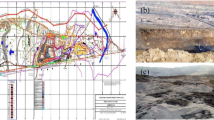Summary
From a purely mechanical viewpoint, each explosive charge should produce a peak blasthole pressure (P b ) that just fails to crush (i.e. pulverise or plastically deform) the rock which surrounds it. WhereP b exceeds a critical value, some explosion energy is wasted in crushing an annular section of rock immediately around each charge. As a rock's dynamic compressive breaking strain decreases, so shouldP b (Hagan, 1977b).
This paper reviews information on, and anticipates the blasting performance of, bulk charges having effective densities which are as low as about 40% of that for ammonium nitrate fuel oil (ANFO). It also outlines the potential advantages of extending the reaction periods of charges, even to the extent that explosive reactions continue after the blasthole wall and stemming have started to move. The paper then proceeds to define situations in which the use of such lower-pressure charges is likely to result in greatest reductions in mining costs. Some methods of applying bulk charges having effective densities in the 0.3–0.8 g cm−3 range and/or lower reaction rates are suggested.
Similar content being viewed by others
References
Barab, J. (1927)Modern Blasting in Quarries and Open Pits, Hercules Powder Company, Wilmington, Delaware, p. 74.
Cole, R.H. (1948)Underwater Explosions, Princeton, New Jersey, Princeton University Press.
Cook, M.A. (1958)The Science of High Explosives, New York, Reinhold.
Cook, M.A. (1961) AN slurry blasting agents,Quarterly Colorado School of Mines 56 no. 1, p. 199.
Drukovanyi, M.F.et al. (1971) Controlled reduction of a stress field due to loads induced by blasting,Soviet Mining Science, p. 509.
Duvall, W.I. and Atchison, T.C. (1957) Rock breakage by explosives,United States Bureau of Mining, R.I. 5356.
Greeff, P. (1977) The use Isanol at Rosebery Mine,Proceedings of the Australasian Institute of Mining and Metallurgy Annual Conference, Tasmania, p. 249.
Greenelsh, R.W. (1985) The N663 stope experiment at Mount Isa Mines.International Journal of Mining Engineering,3 p. 183.
Hagan, T.N. (1977a)Overbreak control blasting techniques, Chapter 11 of the Australian Mineral Foundation's Drilling and Blasting Technology Course, Adelaide May 2–6.
Hagan, T.N. (1977b) Rock breakage by explosives, Invited paper at 6th Int. Colloquium on Gas Dynamics of Explosions and Reactive Systems, Stockholm, Aug.
Kochanowsky, B.J. (1964) Discussion of developments and blasting techniques in opencast mining and quarrying. Proceedings of the Opencast Mining/Quarrying and Alluvial Mining Symposium, London.
Lang, L.C. (1966) Blasting frozen iron ore at Knob Lake,Canadian Mining Journal 87 p. 49.
Langefors, U. and Kihlstrom, B. (1963)The Modern Technique of Rock Blasting, New York, Wiley.
Melnikov, N.V. (1962) Influence of explosive charge design on results of blasting, International Symposium on Mining Research (edited by G.B. Clark), Vol. 1. London, Pergamon, p. 147.
Persson, P.A.et al. (1970) The basic mechanism in rock blasting,Proceedings of the 2nd Congress of the International Society Rock Mechanics, Belgrade.
Author information
Authors and Affiliations
Rights and permissions
About this article
Cite this article
Hagan, T.N., Gibson, I.M. Lower blasthole pressures: a means of reducing costs when blasting rocks of low to moderate strength. International Journal of Mining and Geological Engineering 6, 1–13 (1988). https://doi.org/10.1007/BF00881023
Received:
Issue Date:
DOI: https://doi.org/10.1007/BF00881023




